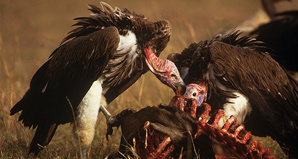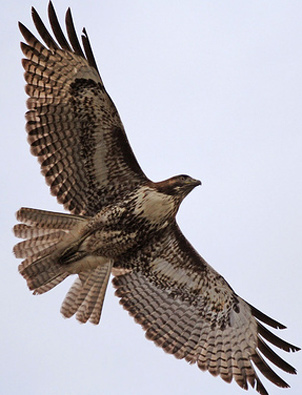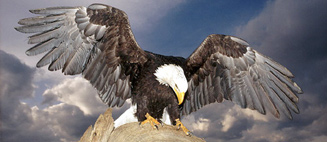
HOME
Non-Flying Birds | Birds of Prey | Extinct Birds | Waterfowl
Bald Eagle
Description
A large raptor, the bald eagle has a wingspread of about 7 feet. Adults have a dark brown body and wings, white head and tail, and a yellow beak. Juveniles are mostly brown with white mottling on the body, tail, and undersides of wings. Adult plumage usually is obtained by the 6th year. In flight, the bald eagle often soars or glides with the wings held at a right angle to the body.
Bald Eagle Distribution and Habitat
Bald eagles are wholly North American, and currently are found in every state except Hawaii, as well as throughout Canada. Eagles prefer undisturbed areas near large lakes and reservoirs, marshes and swamps, or stretches along rivers where they can find open water and their primary food, fish.
Historically, bald eagles nested in forests along the shorelines of oceans, lakes or rivers throughout most of North America, often moving south in winter to areas where water remained open. Prior to the 1900s, they used as many as 80 nest sites in New York, primarily in the northern and western parts of the state.
Wintering grounds are from southern Canada south, along major river systems, in intermountain regions, and in the Great Plains. Many hydroelectric plants, including some in New York, provide suitable wintering habitat for bald eagles.
Food
For a scavenger like the bald eagle, a seal or deer carcass would be an unexpected large food supply. Rich in protein, the bodies will feed a group of eagles for days. Though many calories will be obtained, they will be lost in fighting over the food.

COMMON NAME: vulture
FAMILY
Divided into the "Old World" vultures of Eurasia and Africa (Family Accipitridae) and "New World" vultures of the Americas (Family Cathartidae). Old World vultures are more related to hawks while New World vultures have been genetically linked to storks.
DESCRIPTION
The two families of vultures are classified together based on superficial similarities. Both families have weak feet adapted more for walking than clutching, and feathers that are mostly absent from their heads and necks.
Habbit
Nest-type structure can also be built at ground level and consists of a pile of leaves and branches. Bearded Vultures bathe frequently in mountain ponds and streams.
Feeding
If the bone does not break the first time, the method is repeated many times until the bone finally breaks. The bird then eats the bone pieces starting with the bone marrow. The smaller bones are swallowed whole, as the bird's gastric fluids are so strong that they can digest bone easily. This dietary habit seems odd, but once bones have been digested, they are a nutritious and easily storable type of food; in addition, the bird faces minimal competition for this type of food.

Red-tailed Hawks
The Hawk's scientific name is Buteo jamaicensis.
Discription
Sizes -- Their length is 17 to 22 inches with an average of 19 inches. Their wingspread, depending on the species, ranges from 43 to 56 inches. Their weight ranges from 1.5 to 3.3 pounds, averaging 2.4 pounds.
Colors -- Adults are typically dark brown and the immature ones are gray brown. There are five different species of Hawks in the United states and several more around the world. Their colors vary slightly. They have a quite noticeable shade of red on their tail end. A few species are black, but it is rare.
Habitat
Hawks are a very common type of bird that can be found in every habitat in North America except in the high arctic and in extensive tracts of dense forests. The ones that live in the far north migrate south in autumn (when the cool days begin). They can get down all the way to Mexico and South America. They don't stay in the snow and ice. They return in the spring, which is the breeding season. Hawks live in both open and wooded areas, particularly wood edges. They are often seen perched conspicuously on a treetop.
Eating
While still young and living in the nest, hawks will eat worms and beetles. They will also eat frogs, mice and snakes. As they get older, hawks prey mainly on rodents but also on insects and their larvae, fish, and larger mammals such a rabbits, hares, and squirrels. They will also eat carrion.
If a hawk finishes a meal with their crop bulging, it may not hunt again for a day or two. The crop is a pouch halfway between the mouth and the stomach, where food is stored and gradually released to the stomach. The crop maintains the steady flow of food needed to sustain these big birds.
One assumption made in the program is that each hawk eats three squirrels per year, that is, it needs at least three to survive. This is a BIG assumption because hawks eat many other things and if they don't find food in an area they move until they find it. It is also interesting to know that hawks might attack and kill a squirrel but only eat small portions of it. The three squirrels per year assumption was added to have a strong relationship and dependency between the two species. In reality there is a relationship, but it is much more complex -- that involves many more species.
Non-Flying Birds | Birds of Prey | Extinct Birds | Waterfowl
